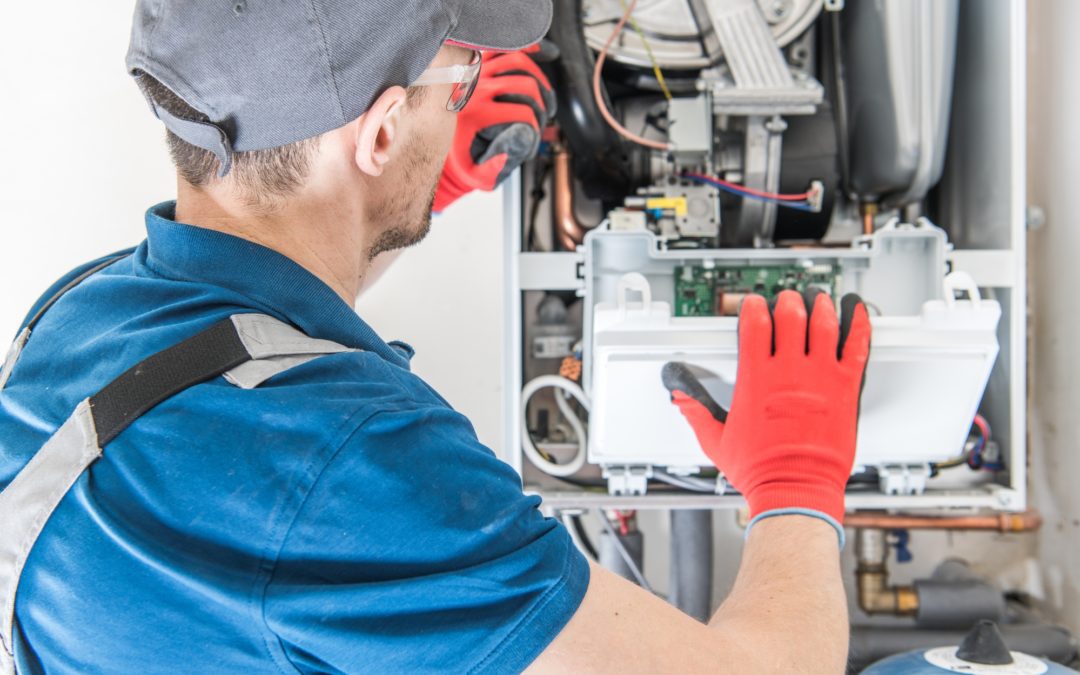There are some appliances in our homes that we typically take for granted, expecting them to “just work” — until they don’t. Air conditioners and furnaces are two such appliances, so commonplace in modern life that we can hardly imagine having a home whose temperature we don’t control. When problems arise, such as spotting water pooling near your furnace, it’s vital to act quickly to avoid bigger problems. A leaking furnace not only seems unusual, but it should also immediately indicate to homeowners that something isn’t quite right with this important equipment. What causes this strange problem, and what can you do about it to make it stop?
Determine What Type of Furnace You Have
The severity of a leaking furnace problem depends primarily on the type of furnace you have. If you have an older style of furnace before the advent of “high efficiency” condensing units, the issue may be more serious and require a more extensive repair. If you have a high-efficiency furnace, the problem is likely not too serious and will be easy to fix. How can you tell the difference?
- A traditional furnace has a metal pipe that runs straight up and away from your unit. The easiest way to identify a conventional furnace installation is to look for this metal pipe.
- High efficiency condensing units use PVC piping for the exhaust tubes instead of metal. If you spy white plastic leading away from the top of your furnace unit, it’s probably a condensing furnace.
After you notice water leaking, your first step should always be to determine what type of furnace you have.
Why Can Some Furnaces Produce Water?
Modern furnaces use two heat exchangers to extract more heating power from every unit of fuel, rather than the single one found in conventional installations. After the fuel combusts and heats the initial exchanger, hot water vapor forms as a by-product of the process. A secondary heat exchanger condenses this gaseous water back into liquid form, causing a release of heat that the furnace also pushes into your home. Water is the natural consequence of this, and in normal operation, it drains away through a special pipe that prevents the water from collecting and damaging the furnace.
Conventional furnaces don’t produce water in this way because the water vapor simply escapes to the outdoors. If you have this type of installation but you’re seeing water collecting where it shouldn’t be, it’s a good sign that there is some other household problem affecting your furnace.
Checking for Possible Solutions to Your Leaking Furnace
If you have a condensing furnace, the first thing you should do is simple — locate the drain trap, typically located somewhere near the drain pipes. If the trap becomes clogged, you’ll need to clear it out, which may stop the problem from recurring. If the trap seems clear or you can’t clear the clog on your own, you’ll need to seek professional help. Likewise, if you spot damage to any of the equipment, especially ruptured drain lines, you’ll need to take corrective action as soon as possible to prevent water damage and ensure the smooth operation of your furnace. Many of these fixes are not in the “do it yourself” category.
Additional Troubleshooting Tips
What if you have a conventional furnace where there is no drain trap or condensate pump? The problem may be with your humidifier, if you have one. This additional equipment helps to regulate the moisture content of the air in winter when you run the furnace, preventing the air from drying out too much. A problem with this unit, which is mostly separate from your furnace, could cause water to appear.
Your vent pipe may also need replacement or redesign. If the exhaust gases cannot quickly escape to the outdoors, they will begin to cool and condense inside the vent pipe itself. This condensation will eventually cause water to trickle back into your home. Again, contact a professional for a repair in this scenario.
Find Professional Help With This Issue from a Furnace Repair Company
If you can’t seem to determine what the problem is with your leaking furnace, or if the problem reoccurs frequently, it’s a good idea to consult a professional technician. Frequent leaks indicate an issue resulting from improper installation, poor maintenance, or failing components. Only a licensed and registered furnace technician should carry out these types of repairs, as furnace equipment can pose dangerous hazards. Typically, this is not the most expensive type of furnace repair, and you should not expect to see the issue again once your technician diagnoses and solves the problem. Have you spotted water near your furnace? Today might be the right time to call a Sonoma County furnace repair provider for easy access to peace of mind.


